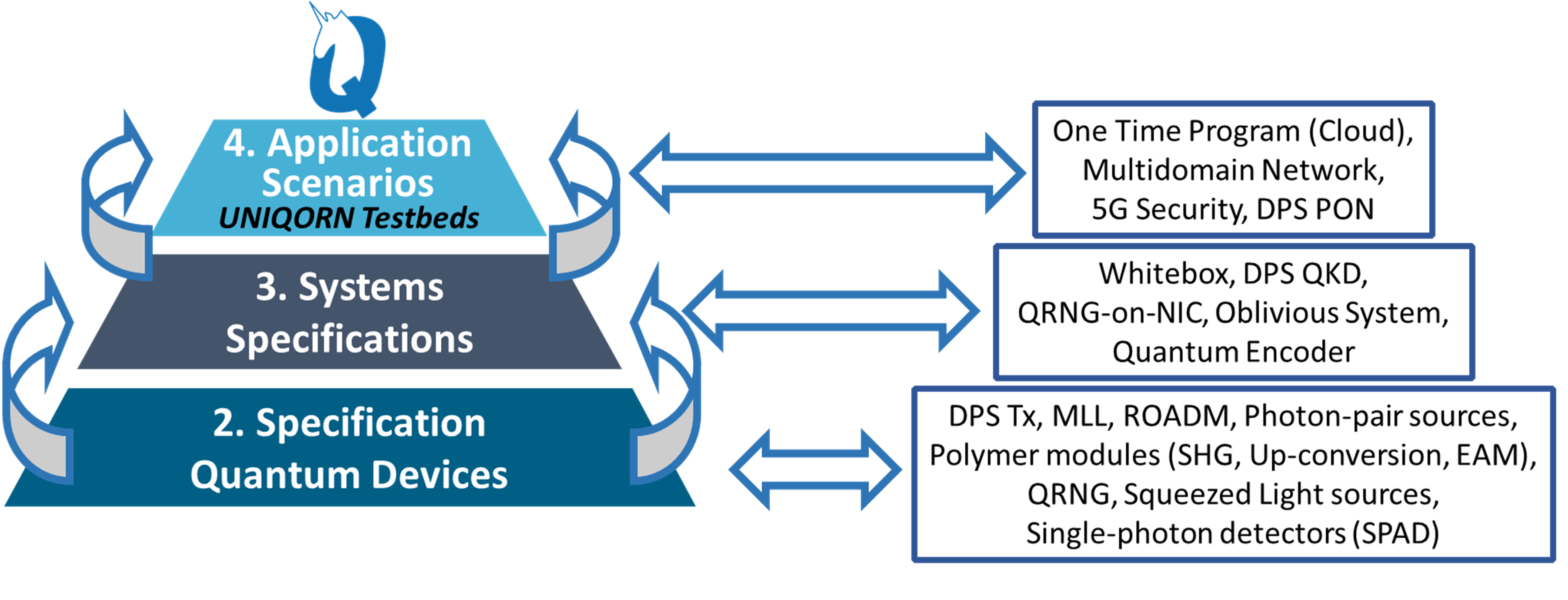Contributing Partners
UNIVBRIS, AIT, UPB, DTU, UNIVIE, MLNX, HHI, ICCS/NTUA, UIBK, TUE, POLIMI, COSM
Executive Summary
The second quantum revolution is imminent and quantum communications is one of the main reasons since it has been identified as information-theoretical secure for data transmission. However, to achieve quantum communication networks, available compact and highperformance modules are needed together with deployed experimental testbeds for the evaluation of these modules with real application scenarios.
Under these premises, the Quantum Flagship UNIQORN project was designed aiming at early prototyping of components and system-on-chip implementations. In UNIQORN, complex systems will be integrated into highly miniaturized quantum-optic modules enabling quantum mechanical features such as entanglement and light squeezing. Moreover, these quantum technologies will be assessed in novel protocols such as oblivious transfer and one-time programs. To prototype these UNIQORN quantum technologies, field trials will be undertaken in city networks and the national dark fibre considering different real network scenarios.
This deliverable D2.1 includes the first steps towards these goals within the UNIQORN project. In D2.1, the main specifications of the UNIQORN quantum technologies are described based on the component and system functionalities of each technology. Initial set of parameters are defined, considering the technologies proposed with view on the integration of systems within potential quantum communication networks and applications. With regards to the applications, D2.1 list important scenarios where the quantum technologies developed in UNIQORN could be implemented.
The methodology used for this deliverable includes the discussion of the quantum devices contemplated within the UNIQORN framework. This will be the foundation for the systems that integrate the different technologies in order to achieve specific functionalities. In turn, the systems created in UNIQORN will be evaluated in field-trials. More importantly, very well-defined use cases will determine the usability of the quantum technologies proposed.

The first part of this deliverable D2.1 includes the description and initial specification of the quantum devices to be developed during the UNIQORN project. One of the quantum devices developed in UNIQORN is the differential phase shift (DPS) transmitter, which is specified in this D2.1. The DPS main building blocks are described considering its functionality and operation. Also, to convert wavelengths in the regime for photon-pair generation, a compactsize mode-locked laser is specified. To this end, different types of photon-pair sources are included in the D2.1, such as polarisation-entangled and time-bin sources. Add-on polymer modules are also specified in this document for different functionalities such as up conversion, SHG and electro-absorption modulator.
The implementation of reconfigurable optical add/drop multiplexers (ROADMs) is also included within UNIQORN for routing telecommunication channels together with quantum channels and initial specifications are included in this deliverable. In addition, the design of quantum random number generators (QRNGs) is included in D2.1 and will exploit a microelectronic chip of Single-Photon Avalanche Diode (SPAD) arrays with 1×2 and 1×16 arrays of single-photon avalanche detectors (SPADs) and the implementation of a continuous-variable (CV) receiver is specified, considering the major challenge of manufacturing coherent detectors.
With regards to squeezed light sources, UNIQORN will follow two approaches in the design. One is based on a periodically poled lithium niobite (PPLN) waveguide and the other approach is based on a bulk PPKTP crystal. The initial specifications of such approaches are listed in this deliverable D2.1.
The second part of this deliverable D2.1 includes the system specifications. In this part, the design of a quantum white box is specified, with the main requirements listed. The main functionality of this quantum white box will focus on the flexible allocation of classical and quantum channels. Also, a DPS QKD system is briefly described in this document, as an integration of the previous work on DPS transmitters. Heralded single-photon sources described in this D2.1 will be built, during the UNIQORN project, with wavelength conversion capabilities based on PPLN waveguides. The specification of a QRNG integrated on a network interface card (NIC) is also described in here for practical evaluation in an operational system.
In addition to the previously mentioned systems, UNIQORN includes the design and specification of the oblivious and one-time program distribution systems, described in this D2.1. In this oblivious system, squeezed light sources will be used to implement an equivalent prepare-and-measure scheme. For the one-time program distribution system, UNIQORN contemplates the demonstration of a quantum information processing to execute and encode classical computation. Initial specifications are described in this document as well.
The third and final part of this deliverable D2.1 includes the UNIQORN application scenarios. One-time programs for cloud processing are detailed in this D2.1 with practical key performance indicators. These programs can be successfully applied with an arbitrarily high success probability in the implementation of one-time digital signatures. Oblivious transfer is also detailed in this document, aiming at the secure database access application.
With respect to optical networks, UNIQORN foresees the application scenarios of multidomain networking, 5G quantum security and DPS-based passive optical network (PON). For the case of the multidomain network, the operator’s metro network of COSMOTE is used as a reference for study of potential coexistence of classical and quantum channels. Then, the networking infrastructure in Bristol is considered for evaluating this coexistence. Regarding the 5G quantum security scenarios, in UNIQORN different aspects are considered and the key performance indicators are listed in D2.1. These 5G quantum security scenarios considered comprise novel 5G fronthaul and backhaul designs, including Internet of Things (IoT) infrastructures secured by quantum communications.
[Download]
